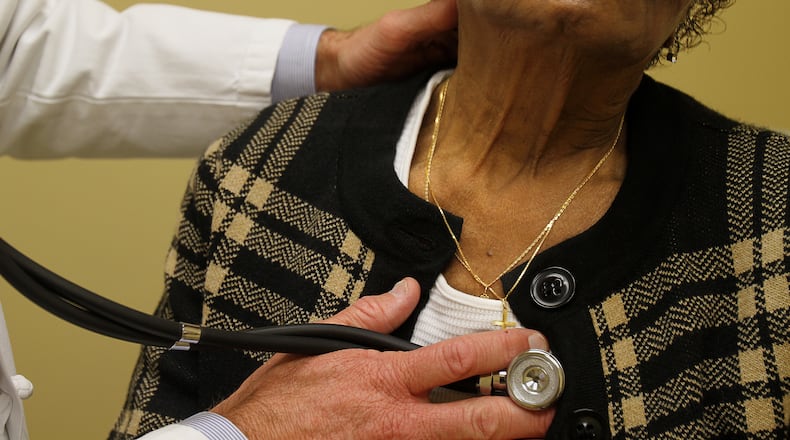Take a version of the quiz given to the participants of the University of Virginia's new study on racial bias in pain assessment and treatment here on myajc.com
Taneisha, a black woman, hobbles into an emergency room with a leg fracture and is in obvious pain. Five minutes later, Katelyn, a white woman, walks into the same emergency room with a fractured wrist. She, too, is hurting.
They’ll both get the appropriate assessment and treatment for their pain, right?
A University of Virginia study released this week says that racial bias, down to the perception of whether a patient has a stereotypical African-American or white name, can determine whether or not the patient’s pain is correctly diagnosed and treated.
Taneisha and Katelyn, along with Jermaine and Brett, were among the names given to mock patients referenced in the U-Va. study. The study found that white medical students who hold false beliefs about biological differences between blacks and whites were more likely to believe a black patient was in less pain than he or she actually was. Those false beliefs, such as black people have thicker skin than white people and black people's nerve endings aren't as sensitive as whites', also led the medical students to make inadequate pain treatment recommendations.
The U-Va. study echoes a 2000 Emory University study that found black emergency room patients were less likely to get adequate painkillers than whites. The Emory study, in fact, found that black patients were 66 percent more likely to receive no pain treatment than whites with similar levels of pain.
Both the U-Va. and Emory studies add to the volume of similar research, stretching back to the 1800s, that documents the role of racial bias in health care for African-Americans.
Tené Lewis, an associate professor of epidemiology at Emory University’s Rollins School of Public Health, said the Virginia study’s findings were “problematic” because they suggested that erroneous beliefs about blacks and whites still held sway in the medical profession. But she expressed hope that the study would lead to change, particularly among budding doctors and nurses.
“The (U-Va.) findings add to an already large body of work in a very elegant way,” said Lewis, who was not involved in either the Virginia or the 2000 Emory studies. “They demonstrate how many educated people still believe these things.”
Lewis, who read the new study this week, said it was “an important first step” in addressing potential bias in health care outcomes.
False Answers Endorsed
The 5-year, U-Va. study published in the Proceedings of the National Academy of Sciences was of 222 white medical students and 92 white people not associated with the medical profession. Each person was asked to rate on a scale of 1 to 4 the amount of pain he or she would feel in several different scenarios, such as accidentally slamming one of their hands in a car door. They were asked to do the same thing for hypothetical black subjects.
Then researchers had the participants answer 15 questions about biological differences between blacks and whites. A full 73 percent of the non-medical participants said at least one of the false items was true, such as "black people's skin is thicker than white people's skin."
The more false answers a person endorsed, the more likely they were to rate the fictional black patient’s pain as lower than that of a white patient with the same condition.
‘Pernicious Consequences’
“People will believe all these things that aren’t based in fact … while not realizing there are pernicious consequences,” said Kelly Hoffman, lead researcher of the U-Va. study.
When the same test was given to medical students, 50 percent of them marked at least one false belief as true. As a result they were less likely to prescribe accurate treatment for the black patient in pain than for the white patient. Dr. M. Norman Oliver, a family medicine physician and one of the co-authors of the U-Va. study, said this indicates not that the students are in any way explicitly racist, but that “implicit bias could have an impact on their decision making in treating pain.”
“People who agreed with those false beliefs were more likely to inadequately treat pain in African-Americans,” said Dr. Oliver. “It was shocking both from African-Americans not getting appropriate pain treatment, to whites having these practically magical ideas about the black body.”
Impact Can Be Subtle
Ideas about biological differences between blacks and whites have held sway for centuries. For instance:
» In the 1850s, Dr. Samuel Cartwright popularized the theory that blacks possessed an “insensibility of the nerves” that made them “insensible to pain when subjected to punishment.”
» During World War II, a cohort of black soldiers were the unwitting subjects of mustard gas and other chemical experiments, the U.S. Army admitted to NPR last year in the network’s investigation of the secret experiments. The goal of the experiments was to see if race affected the way chemical weapons performed.
Those legacies continue to impact in subtle ways, Oliver said.
Messages Implicit And Explicit
“We’re social and cultural animals, and if you grow up in a society with implicit and explicit messages, to say that you walk through that untouched is wishful thinking,” Oliver said. “But (the study subjects) are not people who are racist. We’re talking about people who are anti-racist, but their implicit biases unconsciously impact their decision making.”
When the medical students, from first-years to residents, who participated in the study were presented with the results, they were eager to find ways to incorporate the larger lessons into the curriculum, Oliver said. That gave him hope.
“The good news is because folks are consciously anti-racist, exposing these biases is viewed by them as an aid to improving themselves” as caregivers, Oliver said.
About the Author
Keep Reading
The Latest
Featured


